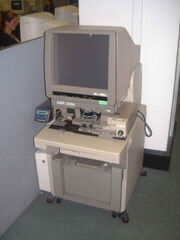
A microfilm viewing machine
Microfilm is an analog storage medium for any type of paper documents, typically books, periodicals, legal documents and engineering drawings. The film itself is a silver halide based film which once exposed is developed using a photographic process.
Microfilm comes in several different formats including 16mm, 35mm and the less used 105mm format. Each format starts as a roll of microfilm, that once developed, can be left in roll form for 16 mm or 35 mm or any of the three sizes can be cut to create microfiche (16mm and 35 mm cut to fit into special pockets on fiche size film are calleed jacketed fiche or simply fiche jackets), and/or aperture cards (35 mm film images cut and attached to an IBM type punched card for ease of use.
Advantages[]

A roll of microfilm
Microfilm is compact, with far smaller storage costs than paper documents. Generally, a year of a periodical in microfilm form takes 10% of the space and 3% of the weight of its paper version. Most microfilm services get a bulk discount on reproduction rights, and have lower reproduction costs than a comparable amount of printed paper. Microfilm is a great archival form. Most library microfilms use polyester with silver-halide dyes in hard gelatin, with an estimated life of 500 years in proper storage conditions. In tropical climates with high humidity, fungus eats the gelatin used to hold silver-halide. In the tropics, diazo-based systems with shorter archival lives (20 years) are preferable, because they have polyester or epoxy surfaces. Finally, since it is analog (an actual image of the original data), it is easy to view. ( much like analog phonograph records having the sound waves carved into the vinyl) Unlike digital media, the data format is instantly comprehensible to persons literate in the language; the only additional equipment that is needed is a simple magnifying glass. This reduces the possibility of incompatibility and obsolescence.
Disadvantages[]
The principal disadvantage of microfilm is that the image is too small to read with the naked eye. Special readers used to be required to project full-size images on a ground-glass screen or a flat reading surface, but recently the computer age has allowed the miniturization and reduced costs associated with film scanners and there are some which work very easily and can produce quite good images form even poor quality microfilm. There is even a recent addition to the available Vier/Scanners which can accept any of the different microform formats; roll, fiche, opaque cards, aperture cards, and even microcards. This latest addition can scan at up to 600 dpi and does so in gray shade to yield true archival digital images. A conventional photocopier cannot reproduce the images and a special combined scanner/printer is required. Libraries using microfilm often have a very limited number of these viewers that can produce a photocopy of an image, for a nominal fee. Shelf space is required to maintain an efficient archive as well as a safe and secure storage environment. The microfilm itself can only be reproduced a limited number of times, while digital media can be recreated infinitely.
Uses[]
Systems that mount microfilm images in punch cards have been widely used for archival storage of engineering information. For example, when airlines demand archival engineering drawings to support purchased equipment (in case the vendor goes out of business), (as of 1999) they normally specified punch-card-mounted microfilm with an industry-standard indexing system punched into the card. This permits automated reproduction, as well as permitting mechanical card-sorting equipment to sort and select microfilm drawings.
Hollerith-mounted microfilm is roughly 3% of the size and space of conventional paper or vellum engineering drawings. Some military contracts around 1980 began to specify digital storage of engineering and maintenance data because the expenses were even lower than microfilm, but these programs are now finding it difficult to purchase new readers for the old formats.
Microfilm first saw military use during the Franco-Prussian War of 1870–71. During the Siege of Paris, the only way for the provincial government in Tours to communicate with Paris was by pigeon post, and as the pigeons could not carry paper dispatches, the Tours government turned to microfilm. Using a microphotography unit evacuated from Paris before the siege, clerks in Tours photograped paper dispatches and compressed them to microfilm, which were carried by homing pigeons into Paris and projected by magic lantern while clerks copied the dispatches onto paper. Each pigeon-load of microfilm was capable of containing up to 40,000 microphotographed dispatches. More information can be found in the Wiki entry for Microforms: http://en.wikipedia.org/wiki/Microform